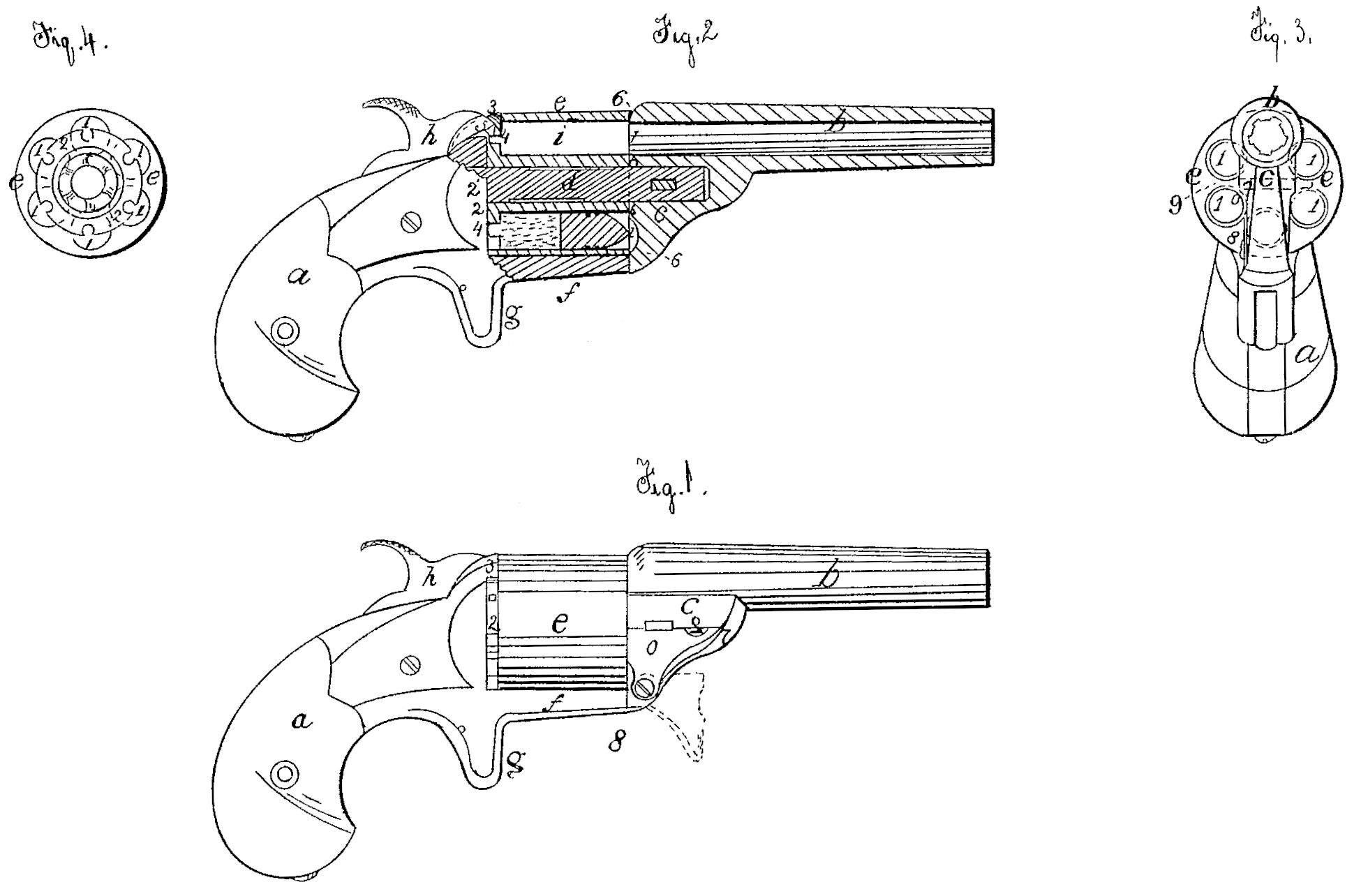US 38321
UNITED STATES PATENT OFFICE.
DANIEL MOORE, OF BROOKLYN, NEW YORK.
IMPROVEMENT IN REVOLVING FIRE-ARMS.
Specification forming part of Letters Patent No. 38,321, dated April 2, 1863.
To all whom it may concern:
Be it known that I, Daniel Moore, of Brooklyn, in the county of Kings and State of New York, have invented, made, and applied to use a certain new and useful Improvement in Revolving Fire-Arms; and I do hereby declare the following to be a full, clear, and exact description of my said invention, reference being had to the annexed drawings, making part of this specification, wherein—
Figure 1 is a side elevation of my pistol. Fig. 2 is a similar view, with the barrel and cylinder in section. Fig. 3 is an end view, and Fig. 4 represents the rear end of the cylinder.
Similar marks of reference denote the same parts.
The nature of my said invention consists in a revolving cylinder with chambers partially open at the rear end, receiving metallic cartridges introduced at the forward end of the cylinder, in combination with a fixed abutment which covers the partial opening at the rear of the chamber on the line of the barrel, so as to sustain the explosion in firing the piece; but the chambers not on line with the barrel are sufficiently open at the rear end for the introduction of a small ram-rod or other device for forcing out the exploded cartridge-case; and I provide a swinging gate that allows for the introduction or removal of the cartridge-cases, but when closed prevents said cases dropping out.
In the drawing, at is the handle, of any usual character or shape. b is the barrel, rifled or plain. c is the bracket of the barrel, receiving the center pin d, on which the cylinder e revolves. f is the arm, extending from the handle a to the bracket c, g is the trigger, and h, the hammer.
The means for rotating the cylinder, the stop to the same or the construction of the lock form no part of my present invention, as they may be made and act in any usual manner.
The cylinder e is formed with chambers 1 1, that do not pass entirely through, but terminate at an abutment, 2, Figs. 1 and 4, at the rear end of the cylinder, which abutment leaves about one-half of the chamber open at the rear end, and this abutment 2, being circular, revolves with the cylinder e beneath an abutment, 3, projecting from the handle, which abutments 2 and 3 sustain the base of the metallic cartridge-case when exploded on the line of the barrel; but the abutment 3 does not extend all around, so that the rear ends of the chambers are partially open for the introduction of a rammer to press out an exploded case, or for observing whether the chamber is loaded or not, and to allow of the removal of dirt from the chamber.
The metallic cartridge-case i is formed with a teat or hollow projection, 4, at the center of its base, entering a notch or hole in the abutment 2, and this teat is to be filled with fulminating material and varnished over, or a small piece of paper introduced to keep the gunpowder from contact there with; and the hammer his formed with a projecting point, 5, that passes through a mortise in the abutment 3 and strikes upon the side of this teat 4 and explodes the fulminate by the compression of the teat against the side of the hole or notch in the abutment 2.
In place of the hammer being formed with a point, it may strike upon a small spring punch, which shall act against the side of the teat.
The forward end of each chamber 1 is recessed to receive the flange or ring 6 around the forward end of the metallic cartridge-case, and this flange or ring being larger than the caliber of the barrel, the said case cannot slide forward and become obstructed, as would some times be the case were the metallic case used without this ring or flange.
In order to introduce or withdraw the cartridge-cases, I recess the side of the bracket c, as at 7, which allows free access to one chamber at a time. In this recess I introduce the swinging gate o, on the center 8. When the same is turned back, as shown by dotted lines in Fig. 1, a cartridge-case can be entered or withdrawn; but when the same is turned up into the recess the end of the gate keeps the cartridges from falling out. A small projection, springing into a notch, keeps this gate in position when turned up, and a thumb-piece, 9, allows for its being pressed down out of the way when desired.
I do not claim a cartridge entered from the front into the chamber; neither do I claim a teat or projection on such case; neither do I claim a flange around the case; but
What I claim, and desire to secure by Letters Patent, is—
1. The circular abutment 2 at the rear end of the cylinder, partially closing the chambers, in combination with a fixed abutment, 3, projecting from the stock and covering the open portion at the rear end of the chamber on line with the barrel, as set forth.
2. The gate o, fitted to swing on the center 8 upon the bracket c of the barrel, and when closed retain the cartridge-cases in the chamber, as set forth.
In witness whereof I have hereunto set my signature this 7th day of February, 1863.
DANIEL MOORE.
Witnesses:
E. Evans,
Lemuel W. Serrell.

